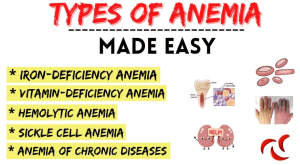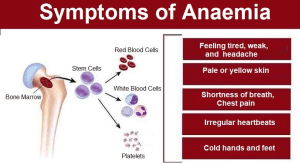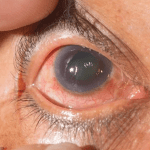The problem of anemia is growing rapidly among women across the world. Acording to WHO globally, anaemia affects 1.62 billion people, which corresponds to 24.8% of the population.Men also suffer from this disease more or less. In medical terms, it is called anemia. Although anemia is not a major disease, but any major disease can start from this anemia. Many people don’t take this problem seriously until anemia reaches a serious level.

But in reality, the result of this negligence is fatal. Therefore, anemia should be taken seriously from the beginning. This problem is mainly due to the lack of iron in the body. So to overcome the problem of anemia, it is necessary to keep the correct amount or balance of iron in the body. And for this, you need enough iron-rich food. So let’s discuss some more about anemia…
What is Anemia?
When the amount of red blood cells or hemoglobin in the blood decreases below normal, it is basically called anemia. Hemoglobin is a protein located in red blood cells that contains iron and transports oxygen.
Also Read – 14 Ashwagandha Benefits, Uses, Doses, and Side Effects
The prevalence of this disease is highest in developing countries. In most cases, women in remote villages suffer from this disease due to malnutrition. As a result of suffering from anemia, various diseases will also start on the body.
It is normal for an adult woman to have 12.1 to 15.1 g / dl of hemoglobin in her blood, 13.8 to 17.2 g / dl for a man, and 11 to 16 g / dl for a child. If someone’s blood hemoglobin is less than that, he is considered to be a patient of anemia.
What Are the Types of Anemia?
There are different types of anemia. These are Aplastic anemia, Hemolytic anemia, Thalassemia, Sickle cell anemia, Pernicious anemia, Fanconi anemia, microcytic anemia, macrocytic anemia, megaloblastic anemia, iron deficiency anemia.

What Is Aplastic Anemia?
In the case of aplastic anemia, small amounts of red blood cells are produced. It may be acquired hereditary. Acquired means that, the disease appeared at some point after born but not born with this disease.
This is called Acquired. Again, if a person has the disease from a parent or family member, then it is called congenital. Acquired conditions can be due to various reasons such as malnutrition, abnormal levels or amounts of hormones, chronic diseases, and pregnancy.
Aplastic anemia does not produce enough red blood cells. In the case of aplastic anemia, the production capacity of the blood decreases.
Also Read – Arthritis: Types of Arthritis, Symptoms and Treatment
In this case, in order to increase the production capacity of the blood, treatment has to be done by inserting micro-cells and red blood cells from outside. Infectious control is required in the treatment of aplastic anemia. This type of anemia results in decreased immunity in aged people.
What Is Hemolytic Anemia?
This type of anemia can be due to congenital causes. Congenital spherocytosis and hemoglobinopathies can also occur. In the case of red blood cells, this type of anemia occurs when the wrong group of blood enters the body.
Also contagious and toxic factors in the body cause the disease. Again, malaria, black fever, arsenic in the water, and a high amount of lead also cause hemolytic anemia.
What Is Thalassemia?
Thalassemia is also congenital. Hemoglobin is a very important component of blood. The job of the hemoglobin is to carry the oxygen that we carry with our breath to all parts of the body. People with thalassemia are unable to make hemoglobin. Hemoglobin is made up of two alpha proteins and two beta proteins. If the production of these proteins in the body decreases, the production of hemoglobin will also decrease. Such patients are completely and partially unable to form globin chains. There are two types of thalassemia: alpha-thalassemia and beta-thalassemia.
Also Read – Peptic or Stomach Ulcer Treatment, Symptoms and Home Remedies
What Is Sickle Cell Anemia?
It is also known as sickle cell disorder. It is a type of hereditary anemia. Red blood cells are usually round and flexible in appearance. Red blood cells can easily pass into blood vessels. When sickle cell anemia occurs, red blood cells become rigid and sticky. And shaped like a sickle or a crescent or a sickle. These abnormal particles get stuck in small blood vessels. As a result, the supply of blood and oxygen to different parts of the body is disrupted. In most cases, the disease is not completely cured. However, it is possible to eliminate various complications and pain through treatment.
What Is Pernicious Anemia?
Lack of vitamin B12 causes Pernicious anemia. This type of anemia is harmful. It is a disease in which large and immature, nucleated cells (megaloblasts, which are the precursors of red blood cells) circulate in the blood but do not work. Failure to absorb vitamin B12 from the gastrointestinal tract causes pernicious anemia. This reduces the number of red blood cells from the blood.
What Is Fanconi Anemia?
This type of anemia is very rare. Fanconi Anemia inhibits the growth of DNA in the body.
Anemia Symptoms:
As mentioned earlier, anemia reduces the oxygen-carrying capacity of the blood. Here are some following symptoms of anemia.
Also Read – Eczema or Atopic Dermatitis: Eczema Symptoms, Causes, and Treatment
Weakness: Feeling weak is a common symptom of anemia. You may feel exhausted without doing any significant heavy work.
Breathing Difficulty: Most noticeable symptoms of anemia are difficulty breathing.
Feeling uncomfortable: Sometimes you may feel a lack of well-being. Also, an unknown uncomfortable feeling may come.
Pica: Pica is the act of eating or wanting to eat something that is not eatable, like ice and soil.

Anemia Causes/ What Causes Anemia?
There are three main Causes of Anemia. These are hemorrhage, decreased production of red blood cells, and loss of red blood cells. These three factors reduce the amount of iron in the blood. Lack of nutrition in food causes anemia.
Women who have excessive amounts of menstruation are more likely to develop anemia. Anemia can also result from a long-term illness. Anemia can also occur in people who have been suffering from chronic renal failure for a long time.
Sometimes it can be a disease in itself, such as anemia due to lack of production of all blood cells. For some diseases such as malaria, black fever, tuberculosis, liver problems, kidney problems, fecal absorption, or anemia can occur if there is any difficulty in the process of digestion and absorption of nutrients.
Anemia can also cause due to Accidental bleeding, vomiting, Suffering from cancer for a long time, suffering from worm related diseases, due to pregnancy. Some medications, such as anti-cancer drugs, are used to treat anemia. Lack of vitamin C and folic acid and lack of B12 can also cause hypothyroid anemia.
Complications for Anemia:
- Problems occur in pregnant women who have severe anemia. This problem is usually severe during and after the baby is born. There is usually a lot of bleeding during childbirth. Excessive bleeding while having anemia can cause serious problems. If the mother has severe anemia, the baby may be preterm and underweight. The child may also develop anemia later in life.
- As a result of anemia, fatigue can affect a patient’s life activity. As a result, the patient feels extra fatigue in any task. Prolonged fatigue can also cause mental depression.
- If anemia patients are not treated for a long time, they become very ill due to infectious diseases.
- In patients with anemia, the heart needs large amounts of blood to produce oxygen and nutrients. In most cases, there is a possibility of heart failure.
- Vitamin B-12 deficiency is also a cause of anemia. This can lead to nerve damage.
Anemia Diagnosis:
Blood test:
It is necessary to check the level of hemoglobin (a type of protein that carries oxygen) and to check if the amount of hemoglobin-rich red blood cells is lower than normal.
Physical examination:
- Fast and irregular heartbeat
- Fast and irregular breathing
- Excessive enlargement of the liver or spleen
Complete Blood Count (CBC):
The number of blood cells in the blood is determined by this CBC test. A doctor examines the levels of red blood cells and hemoglobin in the blood to determine if there is anemia. Although the amount of hemoglobin in the blood of normal adults varies from person to person, it averages 34.9 percent for men and 44.5 percent for women.
Tests to determine the size and structure of red blood cells:
The size, structure, and color of some blood cells are helpful in diagnosing anemia diseases, such as red blood cells due to iron deficiency is relatively small and faded.
Anemia Treatment: How to Treat Anemia?
How to cure Anemia is a common question for anemia patients. Treatment of anemia usually depends on the underlying causes of the disease, the type of anemia, and the overall health of the patient.
Anemia Treatment-Related Some Information is Given Below:
- You need to maintain proper nutrition by taking iron, vitamin B12, and folic acid supplements as directed by your doctor.
- Foods that contain iron should be eaten, such as green leafy vegetables, fresh fruits, eggs, meat, and fish.
- Vitamin-rich fruits such as lemons, oranges, mangoes, etc. vitamin-C supplements are available in the food market. However, ask your doctor what will be the right dose according to your age and body weight.
- Take albendazole tablets once in six months to destroy stomach worms in children.
- Adolescent boys and girls and pregnant women should be given iron and folic acid supplements, whether they have anemia or not.
Anemia Treatment Depending on the Type of Anemia:
- If you have low anemia, your doctor will advise you to eat foods rich in iron and folic acid.
- If you have moderate anemia, your doctor may recommend iron and folic acid supplements. This works especially well when you have no symptoms and you can tolerate oral iron therapy without any side effects, such as gastric intolerance which can lead to diarrhea. If you can’t eat iron-rich foods, the doctor will start treatment with injections. No hospitalization is required for this. After taking the injection you can go home and come back the next day.
- If you have severe anemia, depending on your health, your doctor may recommend an iron injection or hospitalization to check your pulse, blood pressure, and breathing. You may also need to be given oxygen from outside.
- If blood donation is severe then blood must be given from outside.
- Bone marrow replacement: The tissues inside long bones are the bone marrow. Blood cells are made from this bone marrow. Aplastic anemia can damage or damage the inner bone marrow. As a result, blood cells stop forming. Thus, the unstable marrow of a healthy donor has to be surgically replaced in the patient’s body.
- Erythropoietin: Erythropoietin is a hormone in the kidneys. Erythropoietin is needed to make blood cells. Erythropoietin is used to treat anemia in patients who are unable to produce erythropoietin due to kidney damage.
- Splenectomy: a small organ near the stomach called the spleen. Its job is to make new red blood cells and destroy old red blood cells. The lifespan of red blood cells is 120 days. People with anemia sometimes have a tendency to have an excessive breakdown of red blood cells in their spleen. In this case, surgical removal of the spleen is the preferred treatment (splenectomy).
Treatment of Anemia During Pregnancy:
- In low anemia, the hemoglobin level is 9-11 g / deciliter. Your doctor may recommend that you have to take iron and folic acid tablets daily. You may want to check again after a month to see if there is any improvement or not.
- If there is moderate anemia, the hemoglobin level will be 7-9 g/deciliter. In this case, your doctor will first try to find out the cause of the anemia and then start the treatment by taking iron and folic acid tablets. After a month, check if the hemoglobin level is 8-9 g/deciliter. He will try to increase the hemoglobin level to 9 g / deciliter with iron supplement injection.
- If the anemia is severe, the hemoglobin level will be <7 g / deciliter. In this case, your doctor will try to find out the cause and give you the low dose of an iron supplement injection immediately. If the level is very low, you will be advised to take blood from the hospital.
Control Anemia With Lifestyle control:
Anemia can be effectively controlled by making a few lifestyle changes, these are:
- Avoid tobacco: Regular use of tobacco can have a negative effect on iron absorption and metabolism. This will reduce the level of iron in the body. Thus, anemia can be controlled by not using tobacco.
- Do Not Drink Tea With Food: Drinking tea disrupts the absorption of iron. Therefore, if you do not drink tea with food, the absorption of iron will be better.
- Eating Iron-rich Foods: To keep the body hydrated, eat green leafy vegetables, fresh fruits, peas, eggs, fish, and meat.
Anemia Diet: Foods to Prevent Anemia or Control Anemia:
One of the main reasons for anemia is malnutrition. So it is very important to eat iron reach foods and healthy foods that will give the proper nutritional ingredients.
- Peanuts: It is important to eat peanuts every day to get rid of anemia. The iron in peanuts will keep you away from the problem of anemia.
- Eggs: If you make a habit of eating only one egg a day, you can easily stay away from the problem of iron deficiency or anemia in the body. So must include nutritious foods like eggs on your daily diet.
- Dates: The nutritional value of dates is incomparable. Dates are rich in iron. So you can put dates in your regular diet to overcome the problem of anemia.
- Tomato: Tomato is a very easily available vegetable which is very effective in relieving anemia. The iron, vitamin C, and lycopene in tomatoes are able to protect us from various diseases including anemia. So you can put tomatoes in your regular diet.
- Honey: Honey is a high medicinal herbal liquid. Honey is very effective in eliminating the problem of anemia. You can add honey to various foods instead of sugar. It will avoid the harmful effects of sugar also the problem of anemia will be eliminated.
- Other fruits like banana, apple, oranges, and nearly all fruits can be taken in your diet to reduce anemia. Also eat multiple raw vegetables like bit root, carrot, etc.
Final Words:
Anemia is not a dangerous disease, but if you ignore it for a long period of time, many harmful complications will occur, like organ damage, liver problem, gastritis, arthritis, etc. Because blood function and the supply of oxygen in the body will be slow down. And as a result, things will go worse in the future. So don’t neglect, take good care of your health and take nutritious foods, and if necessary go to the doctor for diagnosis and treatment.

